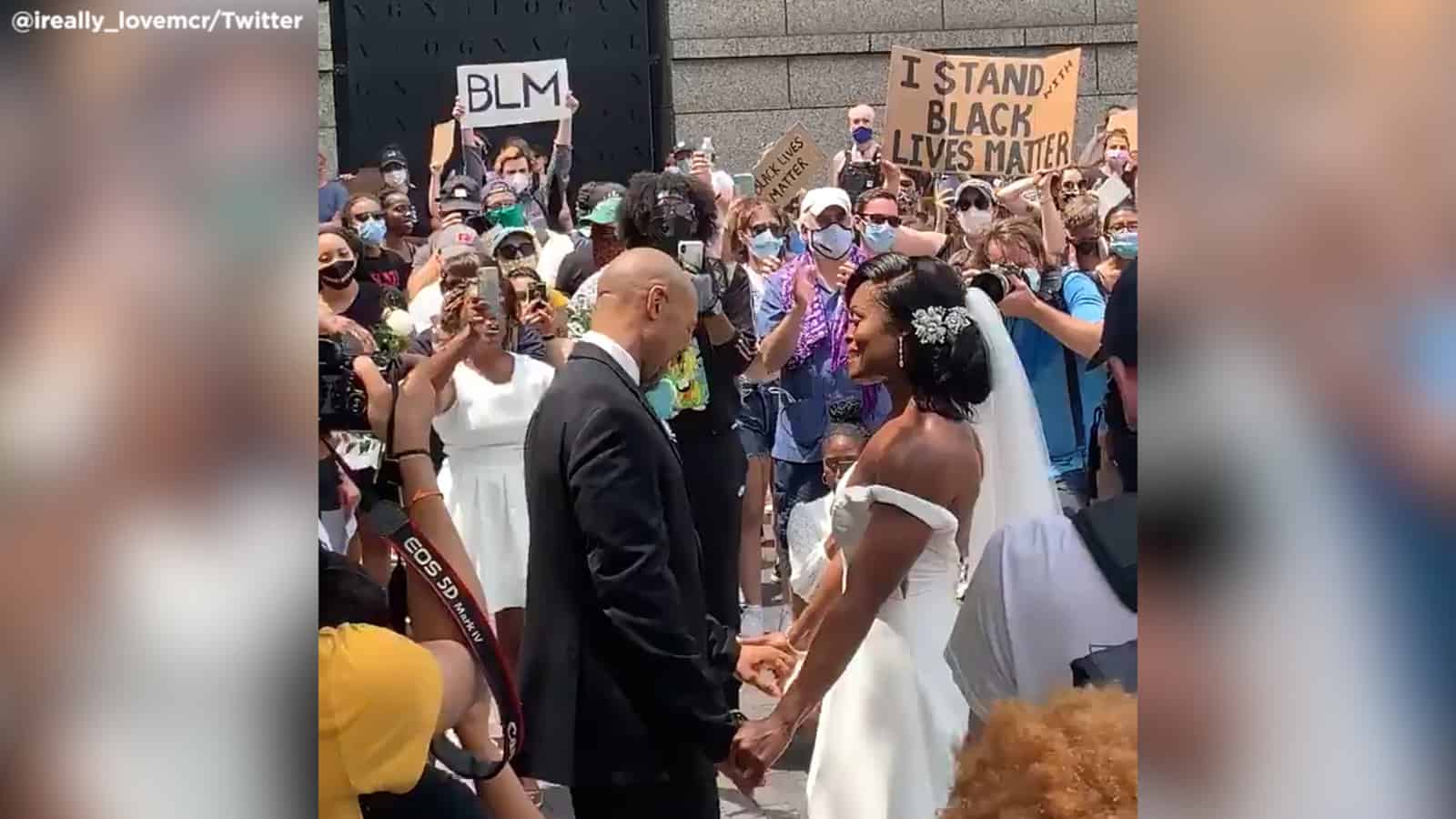With the growing popularity of Handfasting as a ritual to include in a ceremony, member Glenda Procter talks to us at The Celebrant Directory about how to differentiate between a Handfasting and a Handtying.
Many couples seek a Celebrant to perform the ancient ritual of a Handtying, and there are many celebrants advertising their ability to perform a Handfasting.
This is a post for couples seeking a Handfasting, to better understand what it is they actually seek. It will add clarity to any conversation a couple has, when asking for its inclusion within their ceremony.
Glenda of cloud9ceremonies suggests a distinct separation between the two rituals of Handfasting and Handtying, and the names given to them.
She is a double award-winning celebrant with years of experience conducting all types and styles of Handfasting and Handtying Celebrations. She is not known as the Queen of Handfasting for nothing!
What is Handfasting?
A Handfasting is a very old Pagan custom, dating back to the time of the ancient Celts. Quite simply it is the tying of a couple’s hands to denote a union of commitment and love.
A brief history
Handfasting precedes Christianity and this ancient ritual has evolved over time, up until the present day.
The different types of Handfastings seen today all evolved from various elements of several spiritual paths and social traditions. Over the centuries different groups have woven elements of the early Celtic rituals into Handfasting rituals of their own.
Those with a belief in a God, through Angels and Christ will create and wish for one type of emphasis in their Handfasting ceremony. Others will draw on pagan and wiccan rituals.
Modern day couples will seek to add their own ideas, and include varying levels of spirituality.
What do we understand by the expression Tying the Knot?
There are many myths about the origin of the phrase that clearly stems from the Pagan joining of hands in a Handfasting!
Today it has no legal status.
What do we understand about 21st Century Handfastings?
Handfastings have evolved over time to the present day, and will continue to evolve into the future.
Handtying and Handfasting have become more popular, as a way of celebrating love. Couples are choosing the various rituals within a Handfasting and creating beautiful ceremonies.
A Handfasting is the celebration of a commitment of love made between two people to celebrate an engagement, commitment to be together or to celebrate the number of years they have known each other.
Couples and celebrants, each bring various options of rituals into the creating and making of a ceremony. These choices that are made, ensure that a Handfasting Ceremony and all its many associated rituals become personal and significant to a couple.
A Handtying and a Handfasting should be as unique as the couple for whom it is being created and performed.
A modern-day interpretation is now required and certainly needed.
The understanding of a Handfasting in this 21st Century has become truly baffling for both couples and celebrants! In truth it has evolved to be a ‘mashup’ of several different types and styles, influenced by so many attributing factors. The two rituals have become synonymous.
Let’s differentiate
With the growing popularity of Handfasting within the celebrant and officiant community, and it becoming more main stream, I want to create a difference between the description and understanding of Handfasting and a Handtying, so that couples know what it is they seek. This will enable couples and celebrants to understand the rituals involved and the difference in meaning between a Handfasting and a Handtying.
What is the difference between a Handfasting and a Handtying?
I would like to describe a Handfasting Ceremony as a full ritual, involving spirituality and the associated rituals.
I would like to describe a Handtying as the act of tying the hands. A standalone ritual with or without spirituality.
What is a Handfasting?
A full Handfasting ritual will generally be conducted in an outdoor spiritual place, usually in nature and the rituals are all grounded in pagan traditions. A Handfasting ritual does not involve the establishment of church or state. The ceremony is purely spiritual and has no legal status.
Couples may have a deep spiritual connection to nature and wish to hold the ceremony under the sky or stars, outdoors in a magical spiritual place that holds a special significance for them both.
A Handfasting is the complete ritual of not just the Handtying, but the drawing of the blessings of deities or earth entities. The area is blessed and made sacred. It may include the act of toasting and drinking from a loving cup and eating celebratory cake. The ceremony might also include a Sword and Chalice ritual or Oath Stone ceremony. These full Handfasting Ceremonies are meaningful and spiritual. The Celebrant will perform it with purpose and intent, going within, to draw on their own spirituality. The ceremony is performed with reverence and purpose. Each Celebrant will have their own energy to bring to the sacred space.
What is a Handtying?
The Handtying is one ritual taken from a Handfasting Ceremony. It is the act of tying or wrapping the hands in a union of love. A couple may choose to include a Handtying within their traditional English wedding ceremony, using cords and ribbons and making vows and pledges to one another. The ribbons or braids are placed on their joined hands and then bound around to symbolize a union.
In the days of old a village would hold the ritual within the community, and an elder might perform the rituals and blessings. What do we really know?
A modern way…
Couples are seeking new and personal ways to celebrate their love, and choosing to be Handfast as part of a regular wedding celebration! They might choose to tear the clothing they wore on their first date, and use this in a Handtying!
Celebrants are the ones now performing Handfasting
Celebrants create and deliver ceremonies and rituals to meet the requirements of their couples. If a couple are practising pagans, they may not always choose to have a coven priestess conduct their Wedding celebration. It is important that guests feel included, without feeling uncomfortable, by words spoken or rituals used.
Nothing is right, and nothing is wrong…
A Google search is indeed confusing and it often gets even more complicated once YouTube viewing are done! Wikipedia is the most reliable source of information about Handfasting.
Interestingly the term “handfasting ribbon” only appears from about 2005.
Interestingly too… It was only in 2010’s that “Handfasting ceremonies” were listed on offer by commercial wedding organisers and Celebrants.
So much has already become the ‘norm’ and so much is now taken to be truth! The truth is nothing is right, and nothing is wrong. A couple can stand how they wish and hold hands in any way they feel comfortable. The tying can also be created to suit them and their celebrant.
What qualifies me to propose this differentiation between a Handfasting and Handtying?
I have been conducting Handfasting rituals as an Independent Celebrant, for nearly a decade in a vast variety of venues, castles and at festivals. These have been both indoors and outdoors. This alone has given me a huge exposure to hundreds of couples in love; hearing their love stories and above all else establishing their level of spirituality and beliefs as a couple.
I have affectionally been given the name of the Queen of Handfasting and this was emphasised by a lovely comment from a fellow Celebrant.
“Glenda you are not called The Queen of Handfasting for no reason… your courses provide so much practical information and advice that you just can’t find on the internet.”
What do Celebrants offer when they say they perform a Handfasting?
It is very clear that the majority of practising celebrants offering a Handfasting are in fact only available to do a Handtying. What they offer to perform is the tying of a couple’s hands within a regular Wedding Ceremony.
What they believe they are doing and offering is of course a true Handfasting.
But, here is the dilemma
What do we then call a ceremony with full pagan or Celtic rituals within it, that involves the calling of the four elements, cleansing and smudging of the space? A ceremony that requires the preparation for the other rituals within the ceremony, such as drinking from a quaich and Toasting to love. Vows and pledges are created and spoken aloud and can be made whilst holding an Oath Stone. Rings and gifts may also be exchanged. A Sword and Chalice can be included and the ceremony ends with the couple Jumping the Besom Broom.
Confusing isn’t it?
As we become aware of the other types of mini ceremony and rituals, you will begin to understand why I am proposing the differentiations of the two words.
Handtying for the actual tying of the Hands.
Handfasting for the description of more than this.
Working professionally
I would like to really emphasise that there is no right or wrong way for any type of Handfasting or Handtying Ceremony to be conducted.
What is required, is that Celebrants maintain their high level of integrity and working codes of practise. There needs to be honest communication, so that the final ceremony or ritual is indeed authentic and carried out with integrity.
Celebrant’s Spirituality
The spirituality of Celebrants will vary enormously. Not all Celebrants will be comfortable or willing to perform a full Handfasting ceremony, involving the blessings of the elements or the inclusion of a deity or God.
It is important for a Celebrant to disclose this to any couple that enquires of their services. The understanding and compatibility of all things spiritual is essential, for a true match to be made. A Celebrant must also be able to recognise the requests and spirituality of a couple and know when, what they are seeking is beyond their knowledge.
Referring a couple to a fellow Celebrant who is qualified and experienced in creating, advising and supporting a couples with their planned Handfasting would be the most practical and professional thing to do. A high level of integrity should be maintained, throughout.
On reflection
A Handfasting Ritual is not the same as a Handtying.
A Handtying will be performed as part of a Handfasting.
A Handtying is at the heart of a Handfasting Ritual.
Not all Celebrants have the required spirituality to carry out an authentic ritual of a full Handfasting.
Most Celebrants can happily perform a simple Handtying.
I hope this information is helpful and assists you to make informed decisions to plan your Handfasting ceremony and find the questions to ask, to find your perfect Celebrant.
This content was originally published here.

